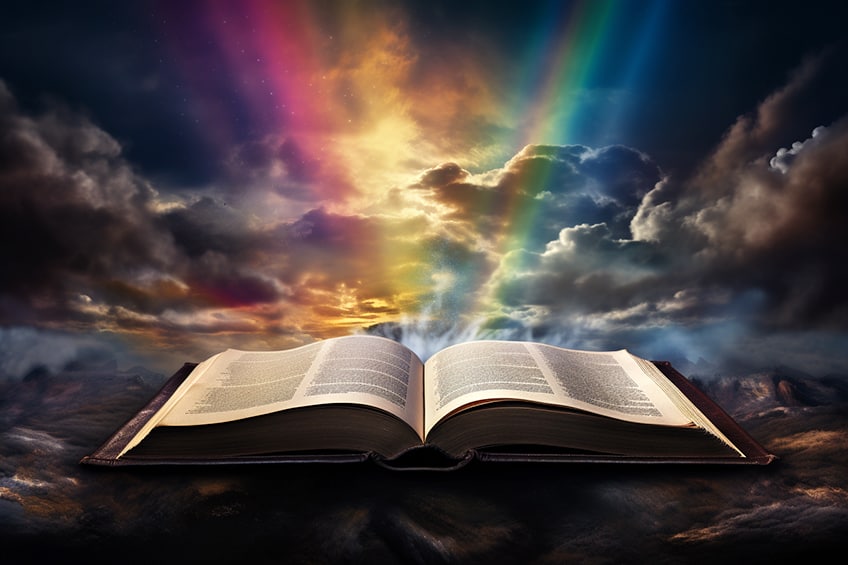Meaning of Colors in the Bible – Deep Meaning of Biblical Colors
You may be wondering if the colors mentioned in the Bible have the same meaning or symbolism as the colors referred to in the scientific study of color psychology. You will find the references to colors throughout the Old and New Testaments of the Bible, and they all have symbolic significance and meaning attached to them. These colors reflect spiritual truths that are there to remind us of God’s amazing plan of redemption for mankind. Let us now consider the symbolism and meaning of colors in the Bible below!
Meaning of Colors in the Bible
It is a known fact that numbers have a symbolic meaning in the Bible, like number one refers to God, number three refers to the trinity, number seven means perfection, and so on. Similarly, colors have symbolic Biblical color meanings, symbolizing God’s Person, and work.
So, if we can understand this symbolism, it will give us a deeper and greater understanding of the Bible.

Bible symbolism forms part of the Hebrew hermeneutics, which is a study of the principles and interpretation of the various books of the Bible. This study approach is referred to as Remez, which means that there is a deeper meaning or hidden message behind the written word. We will be using this method to discover the deeper meaning of colors in the Bible.
Biblical Color Meanings of Primary Colors in the Bible
When looking at the traditional color system, the three primary hues cannot be produced by combining any other color. These three colors are red, blue, and yellow and are colors that can be found in nature and are referred to in the Bible.
Red
The word “red” occurs 53 times in the Bible, and in the Old Testament, the Hebrew word for red is “Oudem”. Red in the Bible is symbolic of sin and bloodshed (Isaiah 1:18). In the Old Testament, the blood of animals was needed to be shed for the atonement of man’s sins (Leviticus 17:11), and during the Passover in Egypt, the Israelites painted the doorposts of their homes with blood to protect them from the angel of death (Exodus 12:1-13).
In the New Testament, the Greek word used for red is “eruthros” and is symbolic of the shedding of the Blood of Jesus Christ on the cross, showing God’s love for man and the salvation of man’s soul (Colossians 1:20), this is very significant as the color of blood is red.
Red in many Christian religions is the official color of the church, with red banners and red clothing. The Hebrew word “Oudem” literally means “red clay” and represents the earth. Adam was created from the dust of the earth (Genesis 2:7), and Esau was born red all over and tilled the ground (Genesis 25:25).

| Shade | Hex Code | CMYK Color Code (%) | RGB Color Code | Color |
| Red | #ff0000 | 0, 100, 100, 0 | 255, 0, 0 |
In the book of Revelation, chapter six speaks of the prophetical end times and refers to a red horse that is symbolic of war and bloodshed. The red horse and rider have the authority to take peace from the world. The same applies to the red dragon in Revelation Chapter 12, which symbolizes Satan’s power to bring bloodshed and death to humanity.
Blue
Blue appears 51 times in the Bible and the Hebrew word for blue is “tekhelet” when translated means light blue or sky blue. In the Old Testament, tekhelet was the color that was specifically assigned for the hem of the priest’s garment (Exodus 28:5-6). In the New Testament, the woman who was healed from the issue of blood touched the hem of Jesus’ garment and was healed, symbolizing God’s healing grace. The hem of the garment was blue (Luke 8:40-48) because Jesus is the High Priest.
The meaning of blue in the Bible can symbolize the sky or heavenly realm. When Moses, Aaron, and his two sons went up to Mount Sinai to worship God, they noticed that under the feet of God was a type of pavement, and it was made of Sapphires, as clear as the bright blue sky (Exodus 24:10).
Sapphires are gemstones that are mentioned in the Bible and reflect the beautiful clear blue-sky color. They are found in the breastplate of the high priest (Exodus 28:18) and will also be part of the twelve foundations in the new Jerusalem (Revelation 21:19).

| Shade | Hex Code | CMYK Color Code (%) | RGB Color Code | Color |
| Blue | #0000ff | 100, 100, 0, 0 | 0, 0, 255 |
The meaning of blue in the Bible can also symbolize God and His holiness. When the Israelites were to move the ark of the covenant, they were to cover it with special animal skins and then a blue-colored cloth was spread over as a final covering, as no man shall be able to see God and live (Numbers 4:5; 2 Chronicles 2:7; Exodus 24: 10; and Ezekiel 1:26). Blue can also be the color that refers to the Holy Spirit and divine revelation (Hebrews 10:15-16). The color blue can also embody God’s grace. Other symbolism and references to the color blue include some of the following.
- The river of God (Revelation 22-1-2),
- Authority and water of the Word (Ephesians 5:26)
- Living water (John 7:38-39)
- Commandments or laws (Numbers 15:38-41).
Yellow
Yellow appears only four times in the Bible, and in Hebrew, the word for yellow is “tsahob” (Leviticus 13:30), and “charuts” (Psalm 68:13). Yellow and gold are used interchangeably in the Bible and symbolize God’s Glory, faith, joy, and anointing. Gold is a precious, sought-after, and very valuable metal that symbolizes God’s love. This also refers to God’s love in sending Jesus to die for the sins of mankind (John 3:16) and refers to His promises (1 Peter 2:7). When God gave Moses instructions for the building of the Tabernacle, they were very clear that all pieces of furniture must be overlaid with pure gold, which would point to Jesus Christ and also the power of God Himself.
Gold is also symbolic of false gods, which issue a warning that all the wealth in the world is not enough to satisfy man’s soul (Ezekiel 7:19), as gold will only leave you wanting more and can never satisfy you completely.
When the Israelites were in the desert and waited for Moses to return from the mountain, they decided to build a calf from pure gold and worship it. Also, in King Nebuchadnezzar’s dream of a statue representing all the kingdoms of the world, the head was made from pure gold, which was symbolic of the sinfulness of Babylon. Yellow may also symbolize uncleanliness. The Old Testament laws state that if anyone has a sore on their body, the priest needs to examine them, and if he finds that the sore is deeper than the skin and has yellow hair in the middle, the priest will declare that person unclean. This person is then marked a leper and must be removed from the camp (Leviticus 13:29-30).

| Shade | Hex Code | CMYK Color Code (%) | RGB Color Code | Color |
| Yellow | #ffff00 | 0, 0, 100, 0 | 255, 255, 0 |
Yellow in the Bible also describes fire, which is symbolic of God’s presence and judgment and how He refines us (Deuteronomy 4:24). Just as the refiner’s fire purifies us so the fire of God removes the dross from our lives (Proverbs 17:3). God rained down fire and brimstone from heaven and destroyed the sinful city of Sodom and Gomorrah (Genesis 19:24). Yellow is also mentioned at Jesus’s birth when the wise men presented the frankincense. This is a yellowish resin that is grown in Palestine and imported from Arabia (Isaiah 60:6 and Jeremiah 6:20, as well as gold.
Biblical Color Meanings of Secondary Colors in the Bible
Secondary colors are those colors that are formed by mixing equal parts of any two primary colors The secondary colors that we are going to discuss are orange, purple, and green. We will now see how these colors are referred to in the Bible.
Orange
Orange is not mentioned in the Bible, so it makes it very difficult for us to understand the symbolic meanings in the scriptures. However, we know that orange is formed by mixing red and yellow. Therefore, we need to consider some Biblical elements or objects that are predominantly orange which can include fire, iron ore, and rust. Fire in the Bible refers to God’s presence, for example, when Moses was in the wilderness, he came across a bush that was on fire, but it was not consumed (Exodus 3:2-5). Also, on the day of Pentecost, the Holy Spirit descended from heaven and filled those who were gathered in the upper room, and cloven tongues of fire appeared on the heads of each one, thus showing the presence of God in the form of the Holy Spirit (Acts 2:3).
Rust has a red color to it and in the Bible, in (Matthew 6:19-20) it is symbolic of corruption, where the treasure is laid up on the earth, instead of laying up treasure in heaven where no thief can ever enter and steal it.
Iron Ore can vary in color from rusty red, and yellow to gray and purple, and is used in (Jeremiah 6:27-30) as representing a rebellious people that rebel against any form of authority. The Bible uses this as a symbol of rebellion that will be judged by God in the same way as metals are tested and purified.

| Shade | Hex Code | CMYK Color Code (%) | RGB Color Code | Color |
| Orange | #ffa500 | 0, 35, 100, 0 | 255, 165, 0 |
Purple
Purple appears 48 times in the Bible. In the Old Testament, the Hebrew word for purple is “argaman”, and in the New Testament, the Greek word for purple is “porphura”, which refers to a purple dye used for dying cloth. Purple in the Bible symbolizes royalty and officials in high positions (Judges 8:26) and symbolizes prosperity, luxury, and wealth (Song of Solomon 3:10 and Luke 16:19).
Purple plays an integral part in the temple that Moses was told to build.
Purple was used for the making of curtains and carpets and was also used for the making of the Priest’s garments (Exodus 25:4, 26:1, 36, 27:16 as well as Numbers 4:13). In the New Testament the robe that the soldiers put on Jesus before His crucifixion was purple (Mark 15:17 and John 19:2,5). Paul during one of his missionary journeys visited Philippi, where he met Lydia who was a seller of purple goods (Acts 16:14).

| Shade | Hex Code | CMYK Color Code (%) | RGB Color Code | Color |
| Purple | #800080 | 0, 100, 0, 50 | 128, 0, 128 |
Green
Green is the first color that is mentioned in the Bible when God had finished creating Adam and Eve and all the animals and birds. He instructed them that they could eat anything that He had created, and every herb and green plant was given to them for food (Genesis 1:29-30).
One of the precious gemstones that are mentioned in the Bible is emerald, with its deep green color.
God used this precious gemstone to adorn Lucifer after He created him (Ezekiel 28:13), it was one of the stones that were found in the High Priests’ breastplate (Exodus 28:18) and is also one of the gemstones that will be part of the New Jerusalem (Revelation 18:19).

| Shade | Hex Code | CMYK Color Code (%) | RGB Color Code | Color |
| Green | #008000 | 100, 0, 100, 50 | 0, 128, 0 |
Biblical Meaning of Other Colors in the Bible
We have discussed the symbolism and meaning of the primary colors and the secondary colors mentioned in the Bible. However, many more colors are mentioned in the scriptures. Below, we briefly mention them and their biblical color meanings.

- Amber: Symbolizes God’s presence, wisdom, passion, and anointing (Ezekiel 1:4).
- Pink: Symbolizes joy, gladness, gentleness, and love (John 3:16).
- Scarlet: Symbolizes royalty and forgiveness of sins (Isaiah 1:18).
- Silver: Symbolizes purity, divinity, truth, and the Word of God (Psalms 12:6).
- White: Symbolizes righteousness, purity, holiness, light, and victory (Revelation 7:14).
- Brown: Symbolizes compassion, salvation, pride, and the earth (Genesis 3:19).
- Black: Symbolizes sin, judgment, sin, curse, death, mourning, and evil (Isiah 59:7-10).
Colors in the Bible are very significant and are rich in symbolism and meaning, as they illustrate the different characteristics of God’s promises and nature. As we comprehend their symbolism, they will help us to gain a deeper and better understanding of the Scriptures. Even though some of the colors are not exactly mentioned, we can understand their symbolism through the spiritual eyes of faith.
Frequently Asked Questions
What Are the Most Recognizable Bible Colors?
Most of us would recognize the Bible colors that are represented in Genesis. Here, you will find a reference to a rainbow, which is made up of red, blue, green, yellow, orange, violet, and indigo. God formed the rainbow as a symbol of the covenant He made with mankind, which was to never destroy the earth again with a flood.
Are Colors in the Bible Relevant to Christians Today?
All the Bible colors mentioned are relevant to Christians today with their symbolism and meanings, as they help us understand biblical concepts better. For example, white is symbolic of our righteousness, yellow for our joy and faith in God, and blue is symbolic of God’s holiness.
What Color Symbolizes Love in the Bible?
Red is the color of blood, which is connected to our hearts, making it the center of passion and love. The heart is always represented as a brilliant red color rendering it a very powerful symbol of love. So, not only does red symbolize love in the bible, but it also has meaning in the world.
In 2005, Charlene completed her Wellness Diplomas in Therapeutic Aromatherapy and Reflexology from the International School of Reflexology and Meridian Therapy. She worked for a company offering corporate wellness programs for a couple of years, before opening up her own therapy practice. It was in 2015 that a friend, who was a digital marketer, asked her to join her company as a content creator, and this is where she found her excitement for writing.
Since joining the content writing world, she has gained a lot of experience over the years writing on a diverse selection of topics, from beauty, health, wellness, travel, and more. Due to various circumstances, she had to close her therapy practice and is now a full-time freelance writer. Being a creative person, she could not pass up the opportunity to contribute to the Art in Context team, where is was in her element, writing about a variety of art and craft topics. Contributing articles for over three years now, her knowledge in this area has grown, and she has gotten to explore her creativity and improve her research and writing skills.
Charlene Lewis has been working for artincontext.org since the relaunch in 2020. She is an experienced writer and mainly focuses on the topics of color theory, painting and drawing.
Learn more about Charlene Lewis and the Art in Context Team.
Cite this Article
Charlene, Lewis, “Meaning of Colors in the Bible – Deep Meaning of Biblical Colors.” Art in Context. November 27, 2023. URL: https://artincontext.org/meaning-of-colors-in-the-bible/
Lewis, C. (2023, 27 November). Meaning of Colors in the Bible – Deep Meaning of Biblical Colors. Art in Context. https://artincontext.org/meaning-of-colors-in-the-bible/
Lewis, Charlene. “Meaning of Colors in the Bible – Deep Meaning of Biblical Colors.” Art in Context, November 27, 2023. https://artincontext.org/meaning-of-colors-in-the-bible/.









